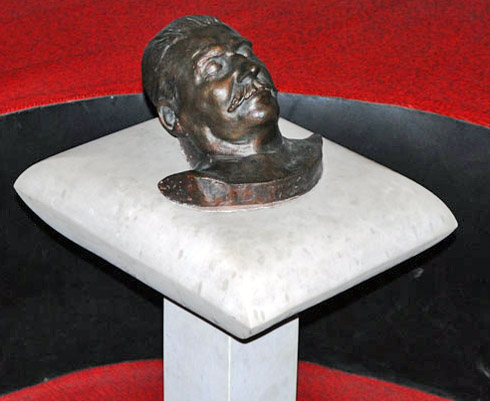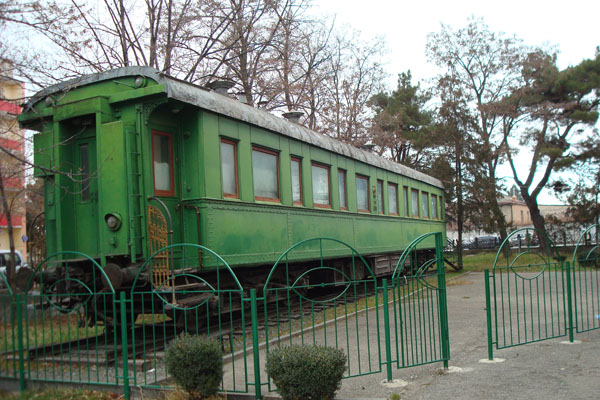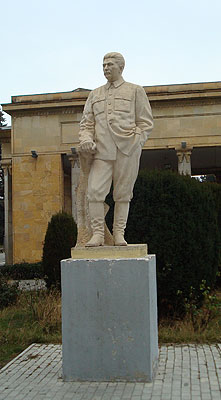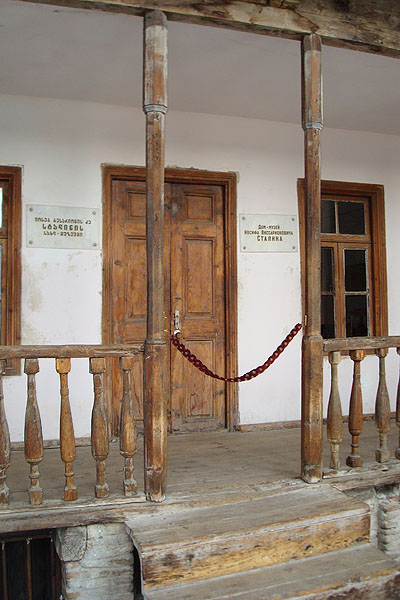
Stalin in death. This is one of the bronze death masks made of Stalin after his death in March 1953. Photo source www.dgrin.com/showthread.php?t=101545
John Sherry, one of my former students, recently visited the Joseph Stalin Museum in Gori, Georgia and sent me some pictures (both below). As I was reading about the museum, I was struck by the fact that (a) it existed; (b) that it still existed in Georgia given the recent hostilities between Russia and Georgia; and (c) that the museum contained a bronze copy of the death mask of Stalin (a death mask is a cast taken from the face of a dead man, which, in this case, was then made into a bronze mask supposedly twelve in number according to Wikipedia).
The museum grounds also contain a very small wooden "house," allegedly Stalin's birthplace way back in 1878, and Stalin's personal, armor-plated, Pullman train carriage which he used during and after World War II.

Stalin's Armored Train Car
Well, the death mask got me to thinking. That's weird. Who made it? Why? When? Where are the other copies? I had many questions, and I have to say that most of them I have not yet been able to answer, but I found out some surprising things about Stalin's death, which I had always known occurred on 5 March 1953 after he had suffered a stroke a few days earlier.
- 1st, and this should not be a surprise, there are conflicting accounts of just what happened during Stalin's final days and how he died. There is, of course, a lot of missing documentation (and a lot of missing people!).
- 2nd, quite a bit of time elapsed between when Stalin was stricken and when medical help finally arrived. That is hard to believe that no one was worried about the absence of Stalin for over fourteen hours.
- 3rd, there have been allegations that Stalin was poisoned with warfarin, a rat poison that prevents the blood from clotting. (Michael Wines, New Study Supports Idea Stalin Was Poisoned)
- 4th, a "PS", just a reminder that Stalin was embalmed after his death and placed in the Lenin Mausoleum on Red Square where he remained until October 1961 when he was removed on Khrushchev's orders and "re-buried" next to the Kremlin wall.
Was there a conspiracy against Stalin? According to Alexander Fursenko and Vitaly Afiani, The Death of Iosif Stalin, International Affairs (Moscow, June 2003), Stalin's communist party leaders left his dacha sometime between 4 and 6 am on the morning of Sunday, 1 March.
Researchers attempted to restore the sequence of events on the basis of the reminiscences of Khrushchev and the guards. In the morning, about 11 hours, when he usually got up from bed, Stalin showed no signs of being around (to quote the security idiom, "there was no movement" in the rooms). Oddly enough, the guards, though feeling anxious, waited till six in the afternoon, when lights went on in one of the rooms. But even after that Stalin gave no signs of being around. The guards still waited till approximately 11 pm. and it was only after the arrival of a courier with Central Committee mail that they entered the small dining room and, on seeing Stalin prostrate on the floor, rushed to call the Security Directorate chief and USSR State Security Minister S.D. Ignatyev, and, that done, informed Malenkov.21
Khrushchev and Bulganin visited the house in the night (though for some reason they did not enter the room, where Stalin was lying). After them Beria and Malenkov came twice, ordering the guards not to disturb the sleeping leader. Sensing that something was wrong, the guards showed more insistence this time. But doctors showed up only in the morning of March 2 with Health Minister A.F. Tretyakov and the Kremlin Medical Administration chief, I.I. Kuperin.
Whenever the stroke had occurred, it was clear was that the leader had remained without medical help for several hours.
On March 4 they informed the public. At 6:30 in the morning the Moscow Radio broke off its broadcasts and the announcer Yury Levitan read "the governmental communication" about Stalin's illness.

